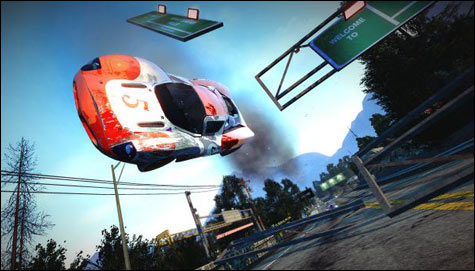
ROAD RAGE? The drawbacks of the new design can be maddening, because the core racing is as exciting as ever.
|
Risk versus reward — that’s what the Burnout series of racing games has always been about. It’s about a lot of other things, too: ludicrous speed, gravity-defying jumps, and epic car crashes. But all of those are rooted in that single concept. Build your speed by weaving through oncoming traffic. Take short cuts by leaping over chasms. Smash opponents to bits, if you don’t wreck your own ride first. It’s a formula that’s produced some of the most thrilling driving games around. The question is why the developers felt the need to overhaul it for Burnout Paradise.
In upshifting to the current generation of consoles, Criterion Games opted to replace the usual menu-driven front end with a persistent open world. Paradise City isn’t huge, as these things go, but it’s densely packed, with multiple race routes, hundreds of off-road shortcuts, and even a few freestyle stunt areas. The compact map offers a diversity of locales, from bustling metropolitan areas to winding mountain passes. Still, the art direction is bland. Paradise City may be a technical marvel, but it has all the artistic appeal of Stalinist architecture.
Because Burnout Paradise is an open world, one in which you don’t have to pursue any of the official race events if you’d rather muck around, a major component of the game is finding hidden objects. Why? Because that’s what all open-world games do, of course. In this case, that means smashing through yellow gates (400 in all) and through Burnout billboards (120 of those). Which is fine as far as it goes — most of the billboards are up so high you may wonder where you’ll find a jump big enough to reach them — but there’s no real reward to finding them, save for the Xbox 360 achievement points.
Okay, the yellow gates usually mark shortcuts. But finding them plays out against the usual spirit of Burnout games. You’ll be blazing down the road, on your way to a race event, and notice a gate you haven’t smashed. You slam on the brakes, throw it into reverse, and then nudge the gates over. Congratulations: you’re one step closer to knocking over all 400 gates! But you’re not improving your racing ability, and you’re also not doing any of the things that make Burnout fun to play.
The drawbacks of the new design can be maddening, because the core racing is just as exciting as ever. Returning from past games are the standard multi-car races, “Burning Route,” in which you race solo against a tight time limit, and “Road Rage,” my favorite, in which the goal is to wreck a certain number of opponents. “Road Rage” comes off the best in the new design, because the lack of a defined route means that a typical event will take you all over the map before you’re done. Races are worse, because one wrong turn can render it impossible to reach the finish line in a competitive time. And there’s no option to quit or restart!
Some of the new choices do work. You can cruise through drive-thrus during races to fill your boost meter or repair any damage. Occasional challenges to hunt down computer-controlled drivers in the city are a blast. And it’s a marvel that you can hop into an on-line game instantly, without waiting in a lobby. Hand it to the folks at Criterion: they took a risk with Burnout Paradise. It just wasn’t quite equaled by the reward.